Gallery
- The West Block of Parliament Hill
- A restored facade of north towers on West Block, Parliament Hill.
- The East Block (left) and West Block (beyond), with its Mackenzie Tower, frame the south facade and Peace Tower of the Centre Block
| Parliament Hill Rehabilitation | |
|---|---|
| Centre Block | |
| Status | Closed |
| Closing date | 2018 |
| East Block | |
| Status | Operating |
| Cost | $167 million |
| Opening date | 1866 |
| Closing date | 2016 |
| West Block | |
| Status | Operating |
| Cost | $863 million |
| Opening date | 2018 |
| Closing date | 2011 |
| Wellington Building | |
| Status | Operating |
| Cost | $425 million |
| Opening date | 2016 |
| Closing date | 2010 |
| Sir John A. Macdonald | |
| Status | Operating |
| Cost | $99.5 million |
| Opening date | 2015 |
| Closing date | 2012 |
| Government Conference Centre | |
| Status | Operating |
| Cost | $269 million |
| Closing date | 2013 |
| General statistics | |
| Total Cost | $3 billion |
The Parliament Hill Rehabilitation is a series of ongoing rehabilitation and preservation projects at the complex on Parliament Hill, in Ottawa, Ontario. The $3-billion project [1] aims to preserve and rehabilitate the Parliament of Canada and various buildings within the Parliamentary Precinct. [2]
A series of interior renovations began in 2002 by the Public Works and Government Services Canada at the direction of the National Capital Commission, [3] and is concentrated on the Centre Block, West Block, and East Block, Library of Parliament, Confederation Building, and the Justice Building. [4]
In 2002, an extensive $1 billion renovation project began across the parliamentary precinct, [5] [6] [7] specifically focusing on masonry restoration, asbestos removal, vehicle screening, parking, electrical and mechanical systems, and improved visitors' facilities. [8] The Library of Parliament and Peace Tower, as well as some exterior areas of masonry on the Centre Block have so far been completed, though focus has shifted to the West Block due to its rapidly deteriorating cladding. Before 2018, when the Centre Block is slated to be closed for five years in order to carry out an extensive interior restoration and upgrade, the inner courtyard of West Block will be enclosed and fitted with temporary chambers for the House of Commons. The Senate will move to the Government Conference Centre. [8]
In 2007, the government approved an updated Long-Term Vision and Plan to be carried out through a series of five-year programs. Each program includes primary projects to rehabilitate key heritage buildings, urgent building repairs to ensure the ongoing viability of buildings and to address health and safety issues, and planning activities to develop the next five-year program. The first priority as outlined in the Long-Term Vision and Plan is to renovate the core historic Parliament buildings, the triad of the West Block, Centre Block, and East Block. The Centre Block cannot be renovated while it is occupied, its occupants will be relocated and will use the East and West blocks as interim space. [2] However, these buildings also need rehabilitation work, which will have to be done first. Before this work can take place, however, the functions displaced from the East and West blocks need to be relocated in interim or new accommodation.
In 1988, the East Block 1910 Wing restoration begins. It was completed in 1997.
In 1992, the West Block project receives preliminary approval. The project receives final approval in 1997, is postponed in 1998, and receives revised preliminary approval in 2005.
In 1993, the Peace Tower masonry repair begins. It was completed in 1997.
In 1995, the Centre Block South façade restoration begins. It was completed in 1998.
In 1997, the construction of Centre Block Underground Services rehabilitation begins. It was completed in 1998.
In 2001, the preliminary approval of new construction, the Bank Street Building, was granted. The Bank Street Building construction was cancelled in 2005.
In 2002, the Library of Parliament rehabilitation begins. It was completed in 2006.
In 2005, projects to provide swing space or relocate functions for West and East blocks begin. These projects are ongoing as of 2015.
In 2010, the Wellington Building rehabilitation begins. It was completed in 2016.
In 2012 the Sir John A. MacDonald Building (previously the Bank of Montreal Building) rehabilitation began. It was completed in 2015.
Planning for the major rehabilitation of Centre Block is currently underway. The building will have to be emptied prior to initiating the rehabilitation. Until the major rehabilitation begins, ongoing maintenance and repair work is being carried out. [8]
The Centre Block is scheduled to close in 2019.
The exterior rehabilitation work underway on the East Block aims to preserve the building's distinctive characteristics. Planning and building investigation work is underway and will include an upgrade to the masonry work on the 1867 Wing of the building. Rehabilitation work has also begun on the Northwest Tower, which will include structural and seismic reinforcement and the installation of a new copper roof. [8]
The East Block rehabilitation work is scheduled to be complete by 2022.
Both the interior and the exterior of the building will be rehabilitated, which will include the restoration of the masonry, modernization of life-safety systems and seismic upgrades. The rehabilitation will include construction of a permanent courtyard infill and the first phase of a visitor welcome centre. [8] Public Works and Government Services Canada will enclose the courtyard of West Block for use as a temporary legislative chamber while Centre Block is out of commission. [9]
The West Block re-opened in 2018.
The Wellington Building, located at 180 Wellington Street was renovated to extend its lifecycle and was repurposed from an administrative office function into parliamentary accommodations so that the East Block and the Centre Block can be emptied and fully restored. [10] It houses 70 parliamentary offices and 10 committee rooms. The work began in 2010 and the building re-opened in 2016.
The building on the southwest corner of Wellington and O’Connor, known to most in Ottawa since it was built in 1930 as the Bank of Montreal building. The Beaux-Arts façade has been conservered with a modern addition to its west at a cost of just under $100 million. [1] It houses parliamentary ceremonial and committee rooms.

Parliament Hill, colloquially known as The Hill, is an area of Crown land on the southern banks of the Ottawa River in downtown Ottawa, Ontario, Canada. Its Gothic revival suite of buildings is the home of the Parliament of Canada and has architectural elements of national symbolic importance. Parliament Hill attracts approximately 3 million visitors each year. Law enforcement on Parliament Hill and in the parliamentary precinct is the responsibility of the Parliamentary Protective Service (PPS).

Rideau Hall is the official residence in Ottawa of both the Canadian monarch and their representative, the Governor General of Canada. It stands in Canada's capital on a 0.36-square-kilometre (88-acre) estate at 1 Sussex Drive, with the main building consisting of approximately 175 rooms across 9,500 square metres (102,000 sq ft), and 27 outbuildings around the grounds. Rideau Hall's site lies outside the centre of Ottawa. It is one of two official royal residences maintained by the federal Crown, the other being the Citadelle of Quebec.

The Canadian Museum of Nature is a national natural history museum based in Canada's National Capital Region. The museum's exhibitions and public programs are housed in the Victoria Memorial Museum Building, a 18,910 square metres (203,500 sq ft) structure in Ottawa, Ontario. The building itself was designated as a National Historic Site of Canada in 1990. The museum's administrative offices and scientific centres are housed at a separate location, the Natural Heritage Campus, in Gatineau, Quebec.
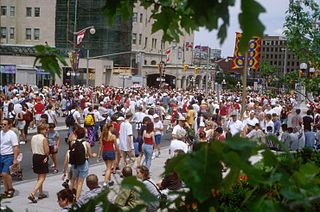
Wellington Street is a major street in Ottawa, Ottawa, Canada. The street is notable for being the main street of the Parliamentary Precinct of the Parliament of Canada. It is one of the first two streets laid out in Bytown in 1826. The street runs from Vimy Place, just west of Booth Street, to the Rideau Canal where it connects with Rideau Street and delimits the northern border of the downtown core. It is named after the Duke of Wellington, in recognition of his role in the creation of the Rideau Canal, and therefore of Ottawa.

The Senate of Canada Building is a building located at 2 Rideau Street in downtown Ottawa, Ontario, Canada that serves as the temporary seat of the Senate of Canada. The building includes the temporary Senate chamber, as well as some Senate offices and committee rooms. The building served as Ottawa's central railway station until 1966, and from 1966 to 2018 it was operated by the federal government as the Government Conference Centre.
The Peace Tower, also known as the Tower of Victory and Peace, is a focal bell and clock tower sitting on the central axis of the Centre Block of the Canadian parliament buildings in Ottawa, Ontario. The present incarnation replaced the 55-metre (180 ft) Victoria Tower after the latter burned down in 1916, along with most of the Centre Block; only the Library of Parliament survived. It serves as a Canadian icon and had been featured prominently on the Canadian twenty-dollar bill directly adjacent the queen's visage, until the change to polymer.

Downtown Ottawa is the central area of Ottawa, Ontario, Canada. Like other downtowns it is the commercial and economic centre of the city. It is sometimes referred to as the Central Business District and contains Ottawa's financial district. It is bordered by the Ottawa River to the north, the Rideau Canal to the east, Gloucester Street to the south and Bronson Avenue to the west. This area and the residential neighbourhood to the south are also known locally as 'Centretown'. The total population of the area is 4,876.
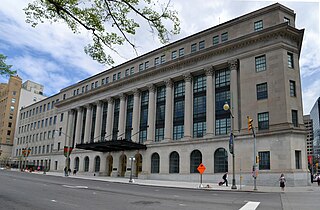
The Wellington Building is a Beaux-Arts architecture office building in Ottawa, Ontario, Canada. It was built between 1924 and 1927 as Canadian headquarters of the Metropolitan Life Insurance Company. The original structure was designed by D. Everett Waid; in 1959, the more restrained classical east wing of the building was added.
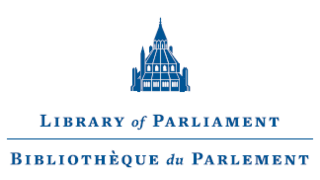
The Library of Parliament is the main information repository and research resource for the Parliament of Canada. The main branch of the library sits at the rear of the Centre Block on Parliament Hill in Ottawa, Ontario, and is the last untouched part of that larger building's original incarnation after it burned down in 1916. The library has been augmented and renovated a number of times since its construction in 1876, the last between 2002 and 2006, though the form and decor remain essentially authentic. The building today serves as a Canadian icon, and appears on the obverse of the Canadian ten-dollar bill.

The National War Memorial, titled The Response is a tall, granite memorial arch with accreted bronze sculptures in Ottawa, Ontario, Canada, designed by Vernon March and first dedicated by King George VI in 1939. Originally built to commemorate the Canadians who died in the First World War, it was in 1982 rededicated to also include those killed in the Second World War and Korean War and again in 2014 to add the dead from the Second Boer War and War in Afghanistan, as well as all Canadians killed in all conflicts past and future. It now serves as the pre-eminent war memorial of 76 cenotaphs in Canada. In 2000, the Tomb of the Unknown Soldier was added in front of the memorial and symbolizes the sacrifices made by all Canadians who have died or may yet die for their country.

The Centre Block is the main building of the Canadian parliamentary complex on Parliament Hill, in Ottawa, Ontario, containing the original House of Commons and Senate chambers, as well as the offices of a number of members of parliament, senators, and senior administration for both legislative houses. It is also the location of several ceremonial spaces, such as the Hall of Honour, the Memorial Chamber, and Confederation Hall.

The Ontario Legislative Building is a structure in central Toronto, Ontario, Canada. It houses the Legislative Assembly of Ontario, and the viceregal suite of the Lieutenant Governor of Ontario and offices for members of the provincial parliament (MPPs). The building is surrounded by Queen's Park, sitting on that part south of Wellesley Street, which is the former site of King's College, which was later leased from the university by the municipal government of Toronto for a "peppercorn" payment of CAD$1 per annum on a 999-year term. The southern portion of the site was later handed over to the provincial government.

The Sir John A. Macdonald Building is a former bank building in Ottawa now owned by the federal government of Canada. It is located at 144 Wellington Street, at the corner of O'Connor Street, with a third frontage on Sparks Street, just in front of West Block of Parliament. Its façade indicates its former heritage as a Bank of Montreal branch location.

The East Block is one of the three buildings on Canada's Parliament Hill, in Ottawa, Ontario, containing offices for parliamentarians, as well as some preserved pre-Confederation spaces.
The Legislative Council of the Province of Canada was the upper house for the Province of Canada, which consisted of the former provinces of Lower Canada, then known as Canada East and later the province of Quebec, and Upper Canada, then known as Canada West and later the province of Ontario. It was created by The Union Act of 1840.
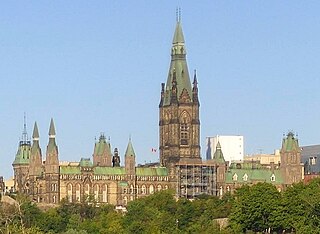
The West Block is one of the three buildings on Parliament Hill, in Ottawa, Ontario. Since 28 January 2019, it has housed the interim House of Commons Chamber, installed to accommodate the House while the Centre Block is closed. The West Block also houses offices for parliamentarians, a branch of the Library of Parliament, committee rooms, and some preserved pre-Confederation spaces.

The Queen's Gates is the formal entrance to Parliament Hill, the location of the Canadian parliament buildings, in Ottawa, Ontario. Built in 1872 and set into the fence, known as the Wellington Wall, between piers designed in the Victorian High Gothic style that was fashionable in Canada at the time, the gates sit on the central axis of the hill's landscaping, in line with the Centennial Flame and Peace Tower beyond, and open onto Wellington Street.
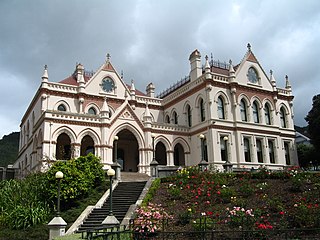
The New Zealand Parliamentary Library is the library and information resource of the New Zealand Parliament. The current library building in Wellington was completed in 1899 and is the oldest of the extant buildings in the Parliament complex. It stands to the north of Parliament House.
Phil R. White is a Canadian artist and sculptor. He is the Dominion Sculptor of Canada, a position whose duties include the creation of original works of art in sculpture. He works are primarily in figurative art. He is an architectural sculptor and carver and creates works in stone, wood, and bronze.

The Canadian Parliament Buildings are the parliament buildings housing the Parliament of Canada, located on Parliament Hill, Ottawa, Ontario, Canada.